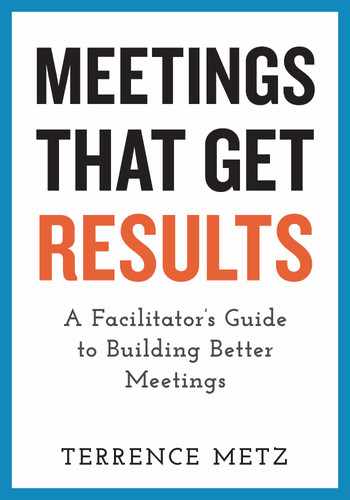Bibliography 
Ackerman, Joshua M., Christopher C. Nocera, and John A. Bargh. “Incidental Haptic Sensations Influence Social Judgments and Decisions.” Science, June 25, 2010.
Besant, Hanisha. “The Journey of Brainstorming.” Journal of Transformative Innovation 2, no. 1 (Summer 2016): 1–7. https://www.regent.edu/acad/global/publications/jti/vol2iss1/Besant_JTISU16A.pdf.
Black, Harvey. “Stop Slouching! Good Posture Boosts Self-Esteem.” Scientific American Mind, May 1, 2010.
Covey, Stephen. The 7 Habits of Highly Effective People. New York: Simon & Schuster, 2013.
Cuddy, Amy. Presence: Bringing Your Boldest Self to Your Biggest Challenges, illustrated ed. New York: Little, Brown, 2018.
Day, George. “Is It Real? Can We Win? Is It Worth Doing?: Managing Risk and Reward in an Innovation Portfolio.” Harvard Business Review, December 2007.
De Bono, Edward. “Six Thinking Hats.” https://www.debonogroup.com/services/core-programs/six-thinking-hats/.
Dyer, Wayne. Change Your Thoughts—Change Your Life, Living the Wisdom of the Tao. Carlsbad, CA: Hay House, 2007.
Erard, Michael. Um: Slips, Stumbles, and Verbal Blunders, and What They Mean. New York: Pantheon, 2007.
Getzels, J. W. “Problem Finding and the Inventiveness of Solutions.” Journal of Creative Behavior 9, no. 1 (1975).
Gleick, James. The Information: A History, a Theory, a Flood. New York: Pantheon, 2011.
Gordon, Thomas. Parent Effectiveness Training: The Proven Program for Raising Responsible Children. New York: Harmony Books, 2000.
Hall, Brian, and Barbara Ledig. Lifestyle Workbook: A Guide for Understanding the Hall-Tonna Inventory of Values. N.p., 1986.
Icebreakers and so on. https://www.teampedia.net/wiki/Main_Page.
International Association of Facilitators (IAF). https://www.iaf-world.org/site/.
Jones, Morgan. The Thinker’s Toolkit: 14 Powerful Techniques for Problem Solving. New York: Times Books, 1998.
Kahneman, Daniel. Thinking, Fast and Slow. New York: Farrar, Straus and Giroux, 2013.
Koestler, Arthur. The Ghost in the Machine. Last Century Media, 1982 (1967).
Maskin, Eric, and Amartya Sen. The Arrow Impossibility Theorem. New York: Columbia University Press, 2014.
Mezick, Daniel. “Connect and Communicate: How to Teach Online.” http://newtechusa.net/danielmezick/.
Mintzberg, Henry, Bruce Ahlstrand, and Joseph Lampel. Strategy Safari: The Complete Guide through the Wilds of Strategic Management, 2nd ed. Toronto: Pearson Education Canada, 2008.
Moore, Geoffrey. Crossing the Chasm. New York: Harper Business, 1995.
NASA (National Aeronautics and Space Administration). “Survival! Exploration: Then and Now.” https://www.nasa.gov/pdf/166504main_Survival.pdf.
National Speakers Association. https://www.nsaspeaker.org/about/.
Newseum. “Today’s Front Pages.” https://www.newseum.org/todaysfrontpages/.
North Carolina State University. “No Laughing Matter: Laughter Can Play Key Role in Group Dynamics.” Science Daily, August 24, 2010. https://www.sciencedaily.com/releases/2010/08/100824103525.htm.
Osborn, Alex. Applied Imagination: Principles and Procedures of Creative Problem-Solving, 3rd ed. New York: Charles Scribner’s Sons, 1963.
Osburn, Jack D., Linda Moran, Ed Musselwhite, and John H. Zenger. Self-Directed Work Teams: The New American Challenge. New York: McGraw-Hill, 1990.
Osburn, J. D., L. Moran, E. Musselwhite, and J. H. Zenger. “Self-Directed Work Teams. The New American Challenge.” Management Revue, April 1991.
Pink, Daniel. When: The Scientific Secrets of Perfect Timing, illustrated ed. New York: Riverhead Books, 2018.
Pinker, Steven. The Stuff of Thought: Language as a Window into Human Nature. New York: Viking, 2007.
Robert, Henry. 1907 Pocket Manual of Robert’s Rules of Order for Deliberative Assemblies. Glenview, IL: Scott Foresman, 1907.
Saj-nicole, Joni, and Damon Beyer. “How to Pick a Good Fight.” Harvard Business Review, December 2009.
Shade, Rev. Frederick A. (compiler). “The Golden Rules,” ed. John Hawkins. Communion, Easter 2020.
Sommer, Tom. “Increasing Alignment.” February 26, 2019. https://medium.com/redbubble/increasing-alignment-a33203fe8687.
Spangler, David. “A Vision of Holarchy,” Seven Pillars: House of Wisdom, https://web.archive.org/web/20120218163022/ http://www.sevenpillarshouse.org/index.php/article/a_vision_of_holarchy1.
Surowiecki, James. The Wisdom of Crowds, reprint ed. New York: Anchor Books, 2005.
Taleb, Nassim. Incerto: Fooled by Randomness, the Black Swan, the Bed of Procrustes, Antifragile, boxed ed. New York: Random House, 2016.
The Nobel Prize. “Paul Krugman.” Press release, October 13, 2008.
Toastmasters International. “Gestures: Your Body Speaks: How to Become Skilled in Nonverbal Communication.” https://www.toastmasters.org/-/media/files/department-documents/education-documents/201-gestures.ashx.
Truss, Lynne. Eats, Shoots & Leaves: The Zero Tolerance Approach to Punctuation. New York: Avery Publishing, 2004.
Tuckman, B. W. “Development Sequence in Small Groups.” Psychological Bulletin 63, no. 6 (1965): 384–399.
Tufte, Edward. The Visual Display of Quantitative Information, 2nd ed. Cheshire, CT: Graphics Press, 2001.
Tynan, Susan, and Ruth Feldman. Communicoding. New York: Dutton, 1989.
Wilber, Ken. A Theory of Everything: An Integral Vision for Business, Politics, Science and Spirituality. Boston, MA: Shambhala Publications, 2000.
Winchester, Simon. The Meaning of Everything: The Story of the Oxford English Dictionary. Oxford: Oxford University Press, 2003.
World Future Society. https://www.worldfuture.org.
